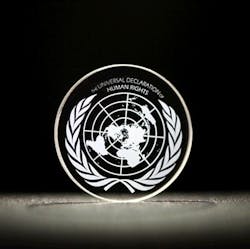Ultrafast-laser writing in quartz produces data storage that lasts billions of years
Using nanostructured glass, scientists from the University of Southampton’s Optoelectronics Research Centre (ORC; Southampton, England) have developed a recording and retrieval process based on femtosecond laser writing in transparent materials, creating birefringent regions that could preserve digital data for billions of years. They call it five-dimensional (5D) digital data, with the three spatial dimensions plus the birefringence’s slow-axis orientation (4th dimension) and the strength of retardance (5th dimension).
The storage allows properties including 360 TB/disc data capacity, thermal stability up to 1,000°C, and virtually unlimited lifetime at room temperature (13.8 billion years at 190°C). As a very stable and safe form of portable memory, the technology could be useful for organizations with big archives, such as national archives, museums, and libraries.
The technology was first experimentally demonstrated in 2013 when a 300 kb digital copy of a text file was successfully recorded in 5D. Now, major documents from human history such as the Universal Declaration of Human Rights (UDHR), Newton’s Opticks, the Magna Carta, and the King James Bible, have been saved as digital copies that could easily survive the human race. A copy of the UDHR encoded to 5D data storage was recently presented to UNESCO by the ORC at the International Year of Light (IYL) closing ceremony in Mexico.
The data is written in three layers of nanostructured dots separated by five μm. The self-assembled nanostructures change the way light travels through glass, modifying polarization of light that can then be read by a combination of an optical microscope and a polarizer.
"This technology can secure the last evidence of our civilization: all we’ve learnt will not be forgotten," says the ORC’s Peter Kazansky.
The researchers presented their research on Wednesday, 17 February 2016 at SPIE Photonics West (San Francisco, CA). The invited paper was called "5D Data Storage by Ultrafast Laser Writing in Glass." The researchers are now looking for industry partners to further develop and commercialize the technology.
Sources:
http://www.southampton.ac.uk/news/2016/02/5d-data-storage-update.page
https://spie.org/PWL/conferencedetails/laser-micro-nanoprocessing

John Wallace | Senior Technical Editor (1998-2022)
John Wallace was with Laser Focus World for nearly 25 years, retiring in late June 2022. He obtained a bachelor's degree in mechanical engineering and physics at Rutgers University and a master's in optical engineering at the University of Rochester. Before becoming an editor, John worked as an engineer at RCA, Exxon, Eastman Kodak, and GCA Corporation.
